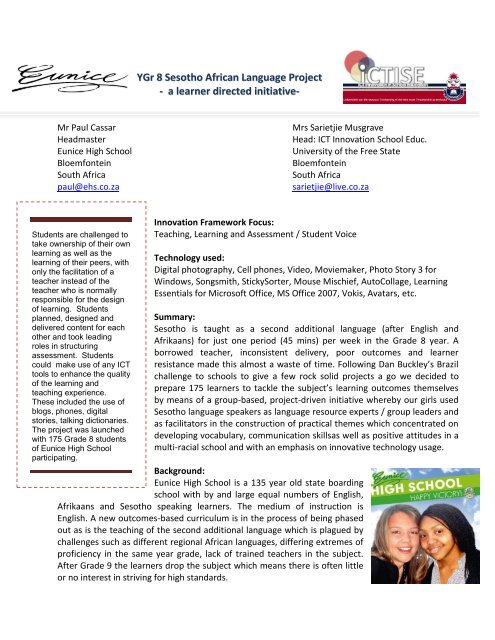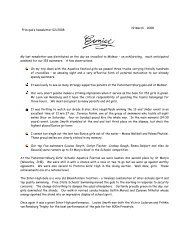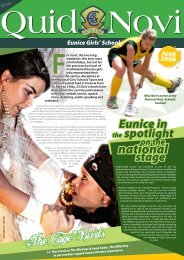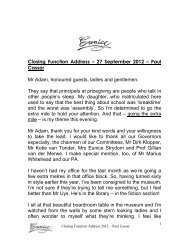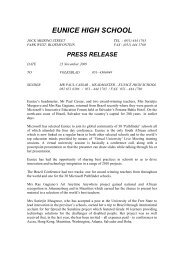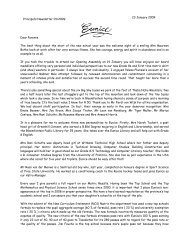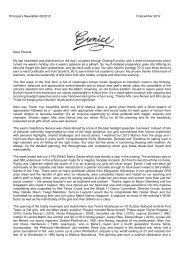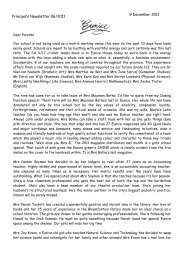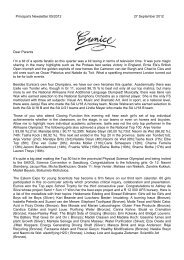Year 8 Sesotho African Language Project draft 2 - Eunice High School
Year 8 Sesotho African Language Project draft 2 - Eunice High School
Year 8 Sesotho African Language Project draft 2 - Eunice High School
Create successful ePaper yourself
Turn your PDF publications into a flip-book with our unique Google optimized e-Paper software.
YGr 8 <strong>Sesotho</strong> <strong>African</strong> <strong>Language</strong> <strong>Project</strong>- a learner directed initiative-Mr Paul CassarHeadmaster<strong>Eunice</strong> <strong>High</strong> <strong>School</strong>BloemfonteinSouth Africapaul@ehs.co.zaMrs Sarietjie MusgraveHead: ICT Innovation <strong>School</strong> Educ.University of the Free StateBloemfonteinSouth Africasarietjie@live.co.zaStudents are challenged totake ownership of their ownlearning as well as thelearning of their peers, withonly the facilitation of ateacher instead of theteacher who is normallyresponsible for the designof learning. Studentsplanned, designed anddelivered content for eachother and took leadingroles in structuringassessment. Studentscould make use of any ICTtools to enhance the qualityof the learning andteaching experience.These included the use ofblogs, phones, digitalstories, talking dictionaries.The project was launchedwith 175 Grade 8 studentsof <strong>Eunice</strong> <strong>High</strong> <strong>School</strong>participating.Innovation Framework Focus:Teaching, Learning and Assessment / Student VoiceTechnology used:Digital photography, Cell phones, Video, Moviemaker, Photo Story 3 forWindows, Songsmith, StickySorter, Mouse Mischief, AutoCollage, LearningEssentials for Microsoft Office, MS Office 2007, Vokis, Avatars, etc.Summary:<strong>Sesotho</strong> is taught as a second additional language (after English andAfrikaans) for just one period (45 mins) per week in the Grade 8 year. Aborrowed teacher, inconsistent delivery, poor outcomes and learnerresistance made this almost a waste of time. Following Dan Buckley’s Brazilchallenge to schools to give a few rock solid projects a go we decided toprepare 175 learners to tackle the subject’s learning outcomes themselvesby means of a group-based, project-driven initiative whereby our girls used<strong>Sesotho</strong> language speakers as language resource experts / group leaders andas facilitators in the construction of practical themes which concentrated ondeveloping vocabulary, communication skillsas well as positive attitudes in amulti-racial school and with an emphasis on innovative technology usage.Background:<strong>Eunice</strong> <strong>High</strong> <strong>School</strong> is a 135 year old state boardingschool with by and large equal numbers of English,Afrikaans and <strong>Sesotho</strong> speaking learners. The medium of instruction isEnglish. A new outcomes-based curriculum is in the process of being phasedout as is the teaching of the second additional language which is plagued bychallenges such as different regional <strong>African</strong> languages, differing extremes ofproficiency in the same year grade, lack of trained teachers in the subject.After Grade 9 the learners drop the subject which means there is often littleor no interest in striving for high standards.
Shared Core Aims:The project simply aimed at making a difference, that is, injecting energy, enjoyment and initiativeand giving learners themselves the chance to take teaching and learning to a higher level using theirown peers’ home language as their major resource and their own creativity as the key driver of thesuccess of the project.Getting Started:Simple StrategiesWe used a flexible approach to timetabling by scheduling both the usual five separate Gr 8 classperiods (facilitated by a school teacher) as well as specially scheduled longer periods for the group asa whole, where a workshop facilitator for the University of the Free State (Sarietjie Musgrave) couldfacilitate and support the groups.During the first workshop with all 175 students, they were urged to thinkabout teaching strategies by inviting them to assess the teaching andlearning styles of successful teachers or memorable lessons in their ownschool experience. They also examined what they appreciated about theirfavourite teachers.Following these reflections on teaching and learning styles, the classeswere divided into groups of 8 by means of an active, fun strategy called“<strong>High</strong> 5” - a group activity used to highlight commonality and explore and celebrate the rich diversityof experiences that different people bring to any group. The workshop facilitator explained that shewould call out different things that may or may not apply to each person. If the item did apply to astudent, they had to run into the middle, jump in the air, and do a high 5 with anyone else who ranin. It started with general items such as: “Are you an only child? ……..have you ever baked a birthdaycake? ……….. to, finally, …is <strong>Sesotho</strong> your home language?”. Those left in the middle were given theopportunity to select team members. And so, quite normally, and on the basis of expertise, these<strong>Sesotho</strong> speaking girls were identified as group leaders.<strong>High</strong>ligts of NationalCurriculum Statement.pptxThe National Curriculum Statement for the subjectwas explained to the teenagers who themselves were to becomeinstant teachers. The learners received no text book, but only a verygeneric “Second Additional <strong>Language</strong> Program Guideline” Discussionsin groups focused on topics such as oral tradition, functionalcommunication, creative ways to design listening, speaking, reading,viewing and writing opportunities, rubrics and assessment.The year was divided into three phases:
Phase 1: Each group selected a theme of their choice and built variouslistening, speaking, reading and writing activities around it. Individualgroups had only themselves as audience.Phase 2: Each group selected a new theme and again developedlistening, speaking, reading and writing activities, but had to present it totheir class (5 groups)Phase 3: The final challenge was: “How can you use technology to teachall other 170 Grade 8 students and an outside audience as much<strong>Sesotho</strong> as possible in 10 minutes with a form of assessment?” Inpreparation for this phase, the students were introduced to cutting edge educational software suchas Moviemaker, Songsmith, Mouse Mischief and AutoCollage. Each group had autonomy over thetechnology they used when presenting to a bigger audience. Almost all 175 girls, even those fromdisadvantaged backgrounds, had cell phones. Learners used their own resources, existing IT labsavailable to them and 30 borrowed laptops from the University of the Free State forpresentation/assessment days.During each of the phases, students attended workshops where progress assessment of groupdynamics took place. Various tools were used for this, but one worth sharing:Each student traced their hand on a sheet of paper.The facilitators guided them through the following 5questions – each question answered inside thecorresponding finger:Thumb: What is really working well in your group?What do you like about the project?Index: Where is your group heading with this topic?What still needs to happen before you can say that youhave been successful? Are you heading in the rightdirections? Are you focused on the task at hand?Middle: What made you cross? What do you not likeabout your group/your topic/the subject? What causesconflict in your group?Ring: Do all your group members show commitment tothe project? How do you show your group that you arecommitted to your group/project? Since the start ofthis project, how has your perception of a secondadditional subject changed? Why?Pinky: What makes you feel vulnerable? Do you haveideas on how to deal with it? What help do you need?
Topics the groups chose included:• How to lose a guy in 10lessons• Learn how to swim• A <strong>Sesotho</strong> driving school• A live cooking show withonline recipes• Growing your own vegetablegarden• A survival guide to a newschool• Running a fashion week inParis• Is she guilty? A court case• A restaurant servingtraditional <strong>African</strong> meals• A traditional <strong>Sesotho</strong>wedding• First ever teenage <strong>Sesotho</strong>magazine• Cops and robbers – aninteractive play for 5 yearolds• Wildlife of South Africa• A road trip through Lesotho• Rights of children in SouthAfrica• CSI – one episode in <strong>Sesotho</strong>• How to use a taxi in SouthAfrica• Saying no to drugs• Zoo – a touch and feelexperience• Helping <strong>Sesotho</strong> speakersfind their way around thehospital• The history of Microsoft andhaving your own <strong>Sesotho</strong>repairs shop• A lesson in self defense• A <strong>Sesotho</strong> fairytalewonderland• Who are the South <strong>African</strong>Ndebele?The Outcomes:The first major improvement came in participation. The project eventually succeeded in activelyinvolving almost every single learner.There was a good balance between peer assessment for learners’ individual contribution and groupassessment by other groups and volunteer teachers.There was definitely an improvement in the learners’ ability to collaborate as a team. The long termnature of the project meant that learners had the time to work through barriers in the need to meetthe deadlines and earn a decent grade.There was something special about Black girls being the leaders of all the groups. This may soundridiculous but, in a South <strong>African</strong> sense, especially in a traditionally Afrikaans-speaking andconservative area, the project provided quality opportunities for changing perceptions, for valuableacademic, social and cultural interaction.A new collaborative relationship was established between the school and one of its neighbouringstakeholders: The unit for ICT Innovation in <strong>School</strong> Education (ICTISE) at the local university, sharingresources, expertise and skills.The final end of year exam was actually an exhibition. More than 200 desks were removed from theexam venue in minutes. Each group was assigned a space and they had a designated time to set up.Soon the hall looked like an innovative teachers’ forum, just a lot noisier! The groups performed their
“We met so many times after school because we really wanted to do well. It was quite a challenge –we had boarders in our group and daygirls who live in the Township. We made a plan”“I have never spoken so much Sotho!”“Our group realized that only we were to blame if we did not do well… we were in charge of our ownlearning… maybe we should have worked harder from the start…”“We decorated our table beautifully. We had 4 laptops on display, each with its own way of helpingthe other people to learn Sotho… In our group we had a bet to see which program would help theother people the most…”“Today we used a lot of pictures. During the year we have learned that using pictures helps a lot – itmakes processing new words easier.”“We took topics that could help us in everyday life.”“…it was great – I think I have learned more than 50 new Sotho words just today! Its just too bad ithad to come to an end!!”Some ChallengesInitially, parents, responding to their children’s concerns, reacted critically. “Why can’t the teacherjust teach?” “This stupid experiment will bring her average down.” “My daughter’s group leader isnot pulling her weight. Can’t she change groups?”Learners tended to begin by being too ambitious. Their second topics were more feasible.Whereas some leaders just taught (I suppose like their teachers). Others soon figured out ways tohelp their group members remember key principles. It took a little time to get the degree of difficultyright. Some did this really well.As educators involved in the project we could follow the journey with the learners and see the meritof the exercise and the general progress. This was not always the case with other teachers wholooked on at the ‘chaos’ from a distance. We think that sharing this case study summary with themcould change their perception.


